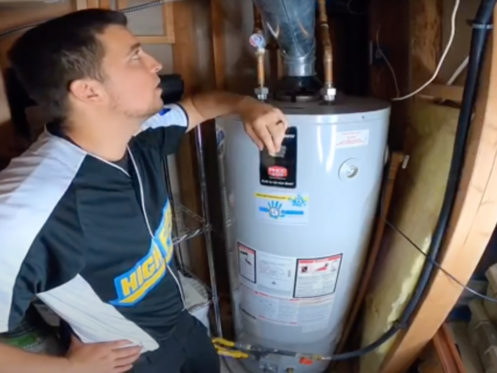Steps to Successfully Care for Your Home's Hot Water System
Steps to Successfully Care for Your Home's Hot Water System
Blog Article
The author is making a number of good points on the subject of Water Heater Maintenance Tips You Can't Afford to Forget overall in this great article on the next paragraphs.

Warm water is vital for daily convenience, whether it's for a revitalizing shower or washing dishes. To guarantee your warm water system runs efficiently and lasts longer, regular upkeep is crucial. This short article provides sensible ideas and insights on exactly how to keep your home's hot water system to stay clear of interruptions and costly repairs.
Intro
Keeping your home's hot water system may seem difficult, but with a few basic actions, you can ensure it operates smoothly for many years to come. This guide covers every little thing from understanding your hot water system to do it yourself maintenance tips and understanding when to employ expert aid.
Significance of Preserving Your Hot Water System
Regular upkeep not just prolongs the life expectancy of your warm water system but additionally ensures it runs successfully. Overlooking maintenance can lead to decreased performance, higher energy bills, and also early failure of the system.
Signs Your Hot Water System Needs Maintenance
Knowing when your warm water system requires interest can avoid significant issues. Watch out for indicators such as irregular water temperature level, weird sounds from the heating system, or rustic water.
Recognizing Your Hot Water System
Before diving into maintenance jobs, it's useful to understand the fundamental components of your warm water system. Generally, this includes the hot water heater itself, pipes, anode poles, and temperature level controls.
Monthly Upkeep Tasks
Regular month-to-month checks can assist capture small concerns before they escalate.
Purging the Water Heater
Flushing your water heater removes sediment buildup, boosting efficiency and prolonging its life.
Monitoring and Replacing Anode Rods
Anode poles prevent corrosion inside the tank. Examining and changing them when worn is crucial.
Inspecting and Adjusting Temperature Settings
Adjusting the temperature setups makes certain optimum efficiency and safety.
DIY Tips for Maintenance
You can do several maintenance tasks on your own to keep your warm water system in leading condition.
Checking for Leakages
Regularly check pipelines and links for leaks, as these can cause water damages and greater expenses.
Evaluating Pressure Relief Valves
Testing the stress safety valve guarantees it works correctly and prevents too much stress accumulation.
Protecting Pipes
Insulating warm water pipes decreases heat loss and can conserve power.
When to Call an Expert
While DIY maintenance is useful, some concerns call for specialist expertise.
Facility Concerns Needing Professional Assistance
Examples include significant leakages, electrical troubles, or if your water heater is consistently underperforming.
Regular Specialist Upkeep Advantages
Professional upkeep can include comprehensive inspections, tune-ups, and making certain compliance with safety criteria.
Conclusion
Normal upkeep of your home's hot water system is important for performance, durability, and price savings. By adhering to these suggestions and understanding when to look for professional aid, you can guarantee a reliable supply of hot water without unanticipated disturbances.
How to Maintain an Instant Hot Water Heater
Before tinkering with your hot water heater, make sure that it’s not powered on. You also have to turn off the main circuit breaker and shut off the main gas line to prevent accidents. Also turn off the water valves connected to your unit to prevent water from flowing into and out of the appliance. 2. When you’re done, you have to detach the purge valves’ caps. These look like the letter “T†and are situated on either side of the water valves. Doing so will release any pressure that has accumulated inside the valves while at the same time avoid hot water from shooting out and burning your skin. 3. When the purge valves’ caps are removed, you have to connect your hosing lines to the valves. Your unit should have come with three hoses but if it didn’t, you can purchase these things from any hardware or home repair shops. You can also get them from retail stores that sell water heating systems. Read the user’s manual and follow it to complete this task properly. When the hosing lines are connected, open the purge port’s valves. 4. You should never use harsh chemical cleaners or solutions when cleaning your unit. Make use of white vinegar instead. It should be undiluted and you’ll probably use about 2 gallons. 5. Now flush your water heater. This task should probably take about 40 minutes. We can’t give you specific directions for this because the procedure is carried out depending on the type, model and brand of your heater. With that being said, refer to the user’s manual. 6. When you’re done draining the unit, you have to turn off the purge port valves again. Remove the hosing lines that you earlier installed on each of the water valves. Put the valve caps (purge port) back in their respective places and be very careful so as not to damage the rubber discs that are found inside these caps. 7. Now that everything’s back in place, check your user’s manual again to find out how to reactivate your water heating system. 8. Once it is working, turn one of your hot water faucets on just to let air pass through the heater’s water supply pipes. Leave the tap on until water flows smoothly out of it. https://www.orrplumbing.com/blog/2014/september/how-to-maintain-an-instant-hot-water-heater/

As an avid reader on How to Maintain a Hot Water Heater in a Few Simple Steps, I think sharing that section was smart. You should take the time to promote this page if you enjoyed reading it. Thanks for your time invested reading it.
Call Today Report this page